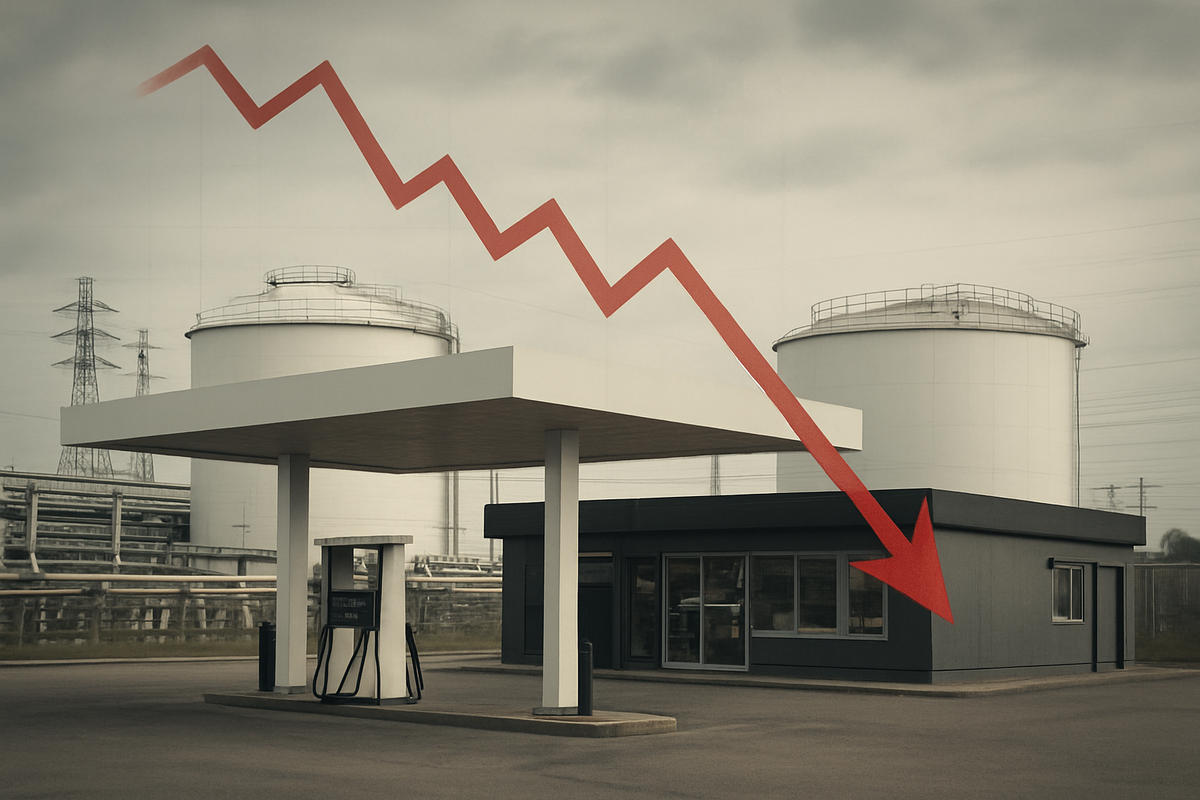Financial News
Global Partners (NYSE:GLP) Plunges to 52-Week Low on Disappointing Q3 Earnings

Boston, MA – November 8, 2025 – Global Partners LP (NYSE: GLP), a prominent energy company, saw its stock price plummet to a new 52-week low following the announcement of weaker-than-expected earnings for the third quarter of 2025. The significant miss on both earnings per share (EPS) and revenue projections has triggered a sharp sell-off, raising concerns among investors about the company's near-term financial health and its ability to navigate a challenging market landscape.
The immediate aftermath of the earnings release saw Global Partners' shares dip considerably, reflecting a strong negative sentiment from the market. This decline underscores investor apprehension regarding the company's operational performance and its outlook, despite a marginal increase in its quarterly dividend. The substantial drop has placed the company under intense scrutiny, prompting a re-evaluation of its market position and future growth prospects.
Detailed Coverage of the Earnings Miss and Market Reaction
Global Partners reported diluted EPS of $0.66 for Q3 2025, falling well short of analyst consensus estimates, which had ranged from $0.85 to $1.10. Revenue figures were equally disappointing, coming in at $4.69 billion against projections that varied between $5.98 billion and $7.28 billion. This substantial earnings miss was the primary catalyst for the stock's precipitous decline.
The timeline of events saw the earnings announcement hitting the wires around November 7th or 8th, 2025. In pre-market trading, the stock immediately declined by approximately 3.84% to 4.5%. As trading commenced on Friday, November 7th, the stock experienced a further drop of 5.26%, moving from its previous close of $44.51 to $42.17. The sell-off intensified, pushing the stock to a new 52-week low of $39.70 (with some reports indicating $41.40) during mid-day trading on Friday, November 8th, with a trading volume of 14,729 shares.
The underlying financial details paint a clearer picture of the challenges faced by Global Partners. Net income decreased significantly to $29.0 million in Q3 2025, down from $45.9 million in the same period last year. Earnings Before Interest, Taxes, Depreciation, and Amortization (EBITDA) also saw a decline, dropping to $97.1 million from $119.1 million, and Distributable Cash Flow (DCF) fell to $53.0 million from $71.1 million. While the Wholesale division showed some resilience, the larger Gasoline Distribution and Station Operations (GDSO) segment experienced a decrease in product margin, contributing significantly to the overall weaker performance. Despite these headwinds, Global Partners did announce a slight increase in its quarterly dividend to $0.755, up from $0.75, which translates to a $3.02 annualized dividend and a yield of 7.0% to 7.2%. However, the company's payout ratio now stands at a concerning 116.15%, raising questions about the sustainability of future dividend increases given the current earnings performance.
Ripple Effects: Winners and Losers in the Wake of GLP's Downturn
The financial stumble of Global Partners (NYSE: GLP) is poised to send ripple effects throughout the energy distribution sector, creating both challenges for its partners and opportunities for its competitors. The most immediate loser, unequivocally, is Global Partners itself, evidenced by its significant earnings miss, revenue shortfall, and the subsequent depreciation of its stock value. Shareholders of GLP are also directly impacted, having witnessed their investments hit a new 52-week low. Furthermore, companies that supply GLP with crude oil, refined products, renewable fuels, or natural gas could face reduced demand or less favorable terms if GLP's financial health continues to decline. Joint venture partners, if any, involved in GLP's terminal operations or distribution services, would also likely suffer from the underperformance of shared projects.
Conversely, GLP's misfortune could translate into gains for its direct competitors, particularly those operating in the same geographic markets and business segments. Regional energy distributors in the Northeast U.S., such as Sprague Operating Resources, are well-positioned to potentially capture market share in both wholesale and retail fuel distribution. If GLP faces sustained operational or financial challenges, its existing customers, including wholesalers, retailers, and commercial clients, might actively seek more stable or competitive alternatives. Larger, more diversified energy companies with significant refining and marketing operations, such as Marathon Petroleum (NYSE: MPC), which boasts substantially higher revenue, could also leverage their scale and financial resilience to absorb GLP's market share by offering more attractive terms or greater reliability to customers.
The struggles within GLP's Gasoline Distribution and Station Operations (GDSO) segment, marked by decreased product margins, could also benefit other retail fuel and convenience store operators. Competitors in the retail space, including other regional chains or companies like TravelCenters of America (NASDAQ: TA), might see an uptick in business if GLP's retail operations continue to underperform. Moreover, if GLP were to consider divesting assets to shore up its balance sheet, these players could acquire valuable infrastructure. While not directly comparable, other midstream logistics and storage providers could also indirectly benefit from any shifts in regional logistics demands if GLP's terminal network experiences reduced efficiency.
Analyzing the Wider Significance: A Microcosm of Industry Challenges
Global Partners' recent earnings miss and subsequent stock plunge are not isolated incidents but rather a stark reflection of several overarching trends and pressures currently reshaping the refined product distribution and broader energy midstream sectors. The company's struggles with decreased product margins in its Gasoline Distribution and Station Operations (GDSO) segment align with a broader deceleration in global demand for refined products. Projections for 2025 indicate a modest worldwide demand growth of just 0.88 million barrels per day (Mbd) year-over-year, a significant drop from previous years, with demand in OECD countries showing particular weakness as the post-COVID recovery in transport fuel demand wanes. This slowing demand, coupled with persistent tight refining margins expected to continue into 2025, creates a challenging operating environment for distributors.
The increasing adoption of electric vehicles (EVs) also represents a structural headwind, gradually eroding the demand base for traditional gasoline, a core product for companies like Global Partners. While the U.S. midstream oil and gas industry is anticipated to see growth opportunities in 2025, largely tied to rising hydrocarbon exports and the growing needs of AI data centers driving natural gas demand, there's a clear divergence. The refined product distribution segment appears to be facing more immediate demand-side pressures compared to the more resilient natural gas transportation sector. This suggests that companies heavily reliant on gasoline and other refined product distribution may continue to face a demanding environment, potentially signaling similar pressures for competitors like USA Compression Partners (NYSE: USAC) and World Kinect (NYSE: WKC), among others in the energy distribution landscape.
The energy distribution sector is also subject to an evolving and often increasing regulatory burden. Environmental regulations, such as the EPA's Renewable Fuel Standard (RFS) and coordinated fuel economy standards, continue to impose compliance costs and disincentivize petroleum-based fuel consumption. Furthermore, state-level oversight is intensifying; California, for instance, has recently implemented new regulations requiring extensive reporting on gross gasoline refining margins. Such trends towards stricter oversight could inspire similar measures in other states where distributors like Global Partners operate, potentially adding to reporting burdens and operational costs. Geopolitical factors and the ongoing global push towards decarbonization further complicate the long-term outlook for fossil fuel-centric distribution.
Historically, the energy sector has been characterized by volatility and periods of underperformance. The U.S. large-cap energy sector frequently ranked as one of the worst-performing groups in the S&P 500 from 2012 to 2021, particularly when oil prices were stable or declining. This historical context suggests that periods of subdued demand and tight margins are not unprecedented, often leading to industry consolidation and capacity rationalization, such as refinery closures. Global Partners' sharp stock decline following its earnings miss is a common market reaction, mirroring similar investor sensitivity seen in other companies that have disappointed financially. This event serves as a reminder of the inherent risks and cyclical nature of the energy market, particularly for segments facing structural demand shifts.
What Comes Next: Navigating Challenges and Seizing Opportunities
In the immediate future, Global Partners (NYSE: GLP) is expected to continue grappling with the pressures of lower fuel margins, particularly within its Gasoline Distribution and Station Operations (GDSO) segment. The third quarter of 2025 saw a significant decrease in gasoline distribution product margin and a 7% year-over-year drop in fuel margins, reflecting a less favorable market than the robust conditions of Q3 2024. The company also acknowledges broader consumer spending pressures affecting lower-income segments and challenges stemming from high labor turnover. However, the Wholesale segment has demonstrated strong performance, buoyed by favorable market conditions for gasoline and ongoing optimization of its liquid energy terminal network, providing a crucial counterbalance to the retail headwinds. Management's commitment to disciplined execution and strategic investments, including planned 2025 capital expenditures for terminal and retail network expansion and the recent expansion of marine fuel supply operations into the Port of Houston, indicates a proactive approach to these challenges.
Looking further ahead, Global Partners' long-term trajectory will be intricately linked to the broader trends within the U.S. midstream energy sector, which is projected to see steady growth driven by increasing oil and gas production and exports. The company's strategy appears to center on leveraging its extensive terminal network to optimize energy distribution, encompassing gasoline, distillates, and a growing focus on renewable fuels. Significant opportunities lie in expanding its natural gas assets, particularly to service the escalating demand from LNG exports and the power needs of AI data centers. Potential strategic pivots for Global Partners could include an accelerated diversification into renewable fuels infrastructure, a more aggressive expansion of its midstream natural gas asset portfolio, enhancing its convenience store offerings beyond traditional fuel sales to include EV charging and diversified consumer amenities, and continuous technological adoption to boost efficiency across its operations.
Several scenarios could unfold for Global Partners. A "Steady Growth" scenario would see the company successfully navigate current margin pressures by maintaining strong wholesale performance and capitalizing on its strategic network expansions, achieving projected growth in earnings and revenue while continuing its consistent distribution increases. Alternatively, a "Margin Compression & Diversification" scenario might force GLP to accelerate its diversification efforts, potentially divesting less profitable retail assets or making bolder acquisitions in high-growth areas like natural gas infrastructure, leading to short-term capital expenditures but positioning for more sustainable long-term growth. Lastly, a "Market Headwind" scenario, characterized by prolonged global oil oversupply, falling commodity prices, and sustained economic slowdown, could impact overall volumes and margins, potentially pressuring the company's dividend policy despite its historical commitment to unitholders.
Comprehensive Wrap-Up: Navigating a Volatile Energy Landscape
Global Partners' (NYSE: GLP) weaker-than-expected third-quarter 2025 earnings report, which sent its stock plummeting to a new 52-week low, serves as a potent reminder of the inherent volatility and external sensitivities within the energy distribution sector. Key takeaways from the quarter include a significant miss on both diluted EPS ($0.66 vs. $1.10 consensus) and revenue ($4.69 billion vs. $7.28 billion consensus), alongside notable declines in net income, EBITDA, and distributable cash flow compared to the prior year. The primary drag came from the Gasoline Distribution and Station Operations (GDSO) segment, which experienced lower fuel margins and reduced retail fuel volumes. However, the Wholesale segment provided a crucial offset, demonstrating strength through improved product margins from gasoline and blendstocks, underscoring the value of the company's expanding terminal network. Despite the challenging financial performance, Global Partners maintained its commitment to unitholders by announcing its 16th consecutive quarterly distribution increase.
Moving forward, the market's assessment of Global Partners will be critical. The immediate negative reaction, pushing the stock close to its 52-week low, reflects investor disappointment and a cautious outlook. The broader midstream energy sector is also navigating a period of commodity price volatility and production adjustments, with analysts anticipating muted Q3 earnings across the industry. While the long-term demand for natural gas, driven by rising North American LNG export capacity and increasing power demands from sectors like AI data centers, offers potential tailwinds for some midstream players, companies heavily reliant on refined product distribution face a more immediate uphill battle. Global Partners' management, while acknowledging the tough retail environment, has emphasized "operational strength" and "focused execution," suggesting a belief in their underlying strategy despite the recent performance.
The significance of this event lies in its illumination of the cyclical nature and external factors influencing energy distribution, particularly the susceptibility of retail fuel profitability to market conditions. It prompts a re-evaluation by investors of GLP's resilience in fluctuating commodity price environments and the effectiveness of its diversification strategy. The substantial disconnect between internal expectations and market perception, as evidenced by the large earnings miss, indicates a period of heightened investor caution. The lasting impact could be a renewed focus on strategic pivots towards more stable or growth-oriented segments of the energy market, accelerating the company's efforts in areas like renewable fuels infrastructure or natural gas assets.
For investors, vigilance in the coming months will be paramount. Key indicators to watch include trends in retail fuel margins and volumes within the GDSO segment for any signs of stabilization or improvement. The continued performance of the Wholesale segment will be crucial as an offsetting factor. Investors should also closely monitor Global Partners' capital allocation decisions and strategic investments, particularly how they align with stated goals of growth and operational efficiency. Broader commodity price movements for crude oil and natural gas will continue to influence overall market sentiment. Finally, any updated analyst revisions or guidance, as well as the sustainability of the company's distributions (assessed through distributable cash flow and coverage ratios), will be critical for assessing the long-term investment thesis for Global Partners.
This content is intended for informational purposes only and is not financial advice
More News
View More



Recent Quotes
View More
Quotes delayed at least 20 minutes.
By accessing this page, you agree to the Privacy Policy and Terms Of Service.



